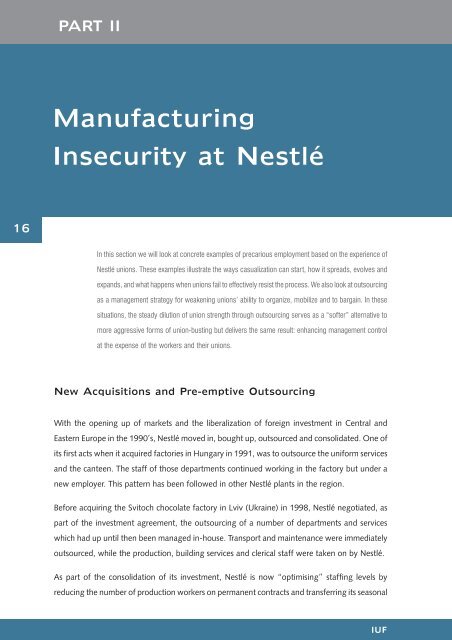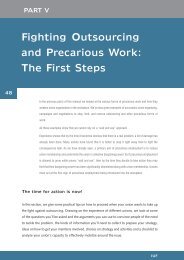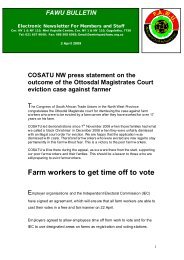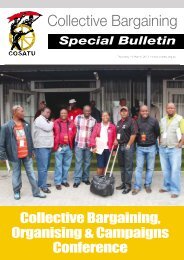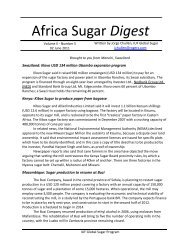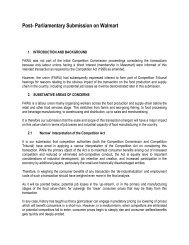PART II: Manufacturing Insecurity at Nestle - Food and Allied ...
PART II: Manufacturing Insecurity at Nestle - Food and Allied ...
PART II: Manufacturing Insecurity at Nestle - Food and Allied ...
You also want an ePaper? Increase the reach of your titles
YUMPU automatically turns print PDFs into web optimized ePapers that Google loves.
16<br />
<strong>PART</strong> <strong>II</strong><br />
<strong>Manufacturing</strong><br />
<strong>Insecurity</strong> <strong>at</strong> Nestlé<br />
In this section we will look <strong>at</strong> concrete examples of precarious employment based on the experience of<br />
Nestlé unions. These examples illustr<strong>at</strong>e the ways casualiz<strong>at</strong>ion can start, how it spreads, evolves <strong>and</strong><br />
exp<strong>and</strong>s, <strong>and</strong> wh<strong>at</strong> happens when unions fail to effectively resist the process. We also look <strong>at</strong> outsourcing<br />
as a management str<strong>at</strong>egy for weakening unions’ ability to organize, mobilize <strong>and</strong> to bargain. In these<br />
situ<strong>at</strong>ions, the steady dilution of union strength through outsourcing serves as a “softer” altern<strong>at</strong>ive to<br />
more aggressive forms of union-busting but delivers the same result: enhancing management control<br />
<strong>at</strong> the expense of the workers <strong>and</strong> their unions.<br />
New Acquisitions <strong>and</strong> Pre-emptive Outsourcing<br />
With the opening up of markets <strong>and</strong> the liberaliz<strong>at</strong>ion of foreign investment in Central <strong>and</strong><br />
Eastern Europe in the 1990’s, Nestlé moved in, bought up, outsourced <strong>and</strong> consolid<strong>at</strong>ed. One of<br />
its first acts when it acquired factories in Hungary in 1991, was to outsource the uniform services<br />
<strong>and</strong> the canteen. The staff of those departments continued working in the factory but under a<br />
new employer. This p<strong>at</strong>tern has been followed in other Nestlé plants in the region.<br />
Before acquiring the Svitoch chocol<strong>at</strong>e factory in Lviv (Ukraine) in 1998, Nestlé negoti<strong>at</strong>ed, as<br />
part of the investment agreement, the outsourcing of a number of departments <strong>and</strong> services<br />
which had up until then been managed in-house. Transport <strong>and</strong> maintenance were immedi<strong>at</strong>ely<br />
outsourced, while the production, building services <strong>and</strong> clerical staff were taken on by Nestlé.<br />
As part of the consolid<strong>at</strong>ion of its investment, Nestlé is now “optimising” staffing levels by<br />
reducing the number of production workers on permanent contracts <strong>and</strong> transferring its seasonal<br />
IUF
workers to a labour-hire agency called NOOSFERA, a company which promotes its services by<br />
pledging on its website “th<strong>at</strong> workers can be substituted or dismissed on dem<strong>and</strong> of the client”<br />
(www.noosfera.com.ua). On any given day, there are about 50 workers out of a total workforce<br />
of 1,200 contracted from NOOSFERA in the plant. In the course of 2005, about 800 NOOSFERA-<br />
contracted workers passed through the factory g<strong>at</strong>es.<br />
Nestlé claims they are “hiring services, not people”. The truth is th<strong>at</strong> workers hired through<br />
NOOSFERA work side-by-side with Nestlé employees, but with lower wages, fewer benefits<br />
<strong>and</strong> no job security. The only guarantee they have is the knowledge th<strong>at</strong> they can be in today,<br />
gone tomorrow. <strong>Insecurity</strong> has been institutionalized as a tool of management control.<br />
When Nestlé acquired the Timashevsk (Russia) facility in 1998, they offered workers fixed-term<br />
contracts in exchange for financial compens<strong>at</strong>ion. Many workers agreed, <strong>and</strong> by the summer of<br />
2005, almost 70% of the workforce was on fixed-term contracts, although they have been<br />
working continuously for the company for years. Until 2004 these contracts were typically for a<br />
period of one year. Since then the company has tended to issue contracts ranging from months<br />
to a few weeks, depending on dem<strong>and</strong>. Nestlé carefully keeps within the law by maintaining the<br />
required gap between contracts, during which time the workers are sent to the st<strong>at</strong>e employment<br />
agency. In times of conflict between management <strong>and</strong> the union, temporary workers have been<br />
thre<strong>at</strong>ened th<strong>at</strong> their contracts would not be extended if they supported their union. In these<br />
cases, acquisition of a new facility was accompanied by the introduction of large-scale casualiz<strong>at</strong>ion<br />
to weaken in advance potential resistance to the imposition of a new management regime. Job<br />
security has been progressively elimin<strong>at</strong>ed to foster dependency <strong>and</strong> to weaken union support<br />
<strong>and</strong> bargaining power.<br />
OUTSOURCING AND CASUALIZATION IN THE FOOD AND BEVERAGE INDUSTRY<br />
17
18<br />
<strong>PART</strong> <strong>II</strong> <strong>Manufacturing</strong> <strong>Insecurity</strong> <strong>at</strong> Nestlé<br />
Creeping casualiz<strong>at</strong>ion <strong>and</strong> outsourcing<br />
The hiring of workers under precarious employment conditions is often a gradual process. It<br />
may seem sudden, especially when you start looking around the workplace <strong>and</strong> realize th<strong>at</strong> a lot<br />
of people around you aren’t regular employees <strong>and</strong> aren’t in the union. Maybe they’re wearing<br />
different uniforms, or the uniforms of labour hiring agencies, or they have irregular working<br />
hours <strong>and</strong> work schedules. A lot of unionists only begin to realize the extent of precarious<br />
employment once they start checking to see who all these ‘new people’ are. Then it comes as a<br />
shock.<br />
But the increased hiring of precarious workers is rarely a sudden, dram<strong>at</strong>ic change by the company.<br />
It’s usually a gradual, creeping process th<strong>at</strong> speeds up as a certain level of precarious employment<br />
is reached. One of the easiest ways to introduce this creeping casualiz<strong>at</strong>ion <strong>and</strong> outsourcing is<br />
through “seasonal” workers who start appearing on a more regular basis, <strong>and</strong> eventually every<br />
month.<br />
The 4 seasons – all in a single day!<br />
In Malaysia, a Nestlé factory producing Milo, Kit K<strong>at</strong>, Smarties <strong>and</strong> other confectionery products<br />
began hiring temporary <strong>and</strong> contract workers on a “seasonal” basis. In 2001, for example,<br />
temporary <strong>and</strong> fixed-term contract workers were hired in the hot months of July, August <strong>and</strong><br />
September. In the following year, they were hired each month from August through to December.<br />
But then in 2003, temporary <strong>and</strong> fixed-term contract workers were hired EVERY month of the<br />
year! By 2004 <strong>and</strong> 2005, these “seasonal” workers were hired <strong>at</strong> any time of the year, regardless<br />
of the season. As a result, on any given day there were so many temporary <strong>and</strong> fixed-term<br />
contract workers coming <strong>and</strong> going th<strong>at</strong> it looked like all the seasons happened in a single day <strong>at</strong><br />
Nestlé!<br />
Similarly, <strong>at</strong> the <strong>Nestle</strong> confectionery factory in Sofia, Bulgaria, a huge percentage of workers is<br />
employed on temporary (yearly <strong>and</strong> shorter) contracts. In summer 2005 (summer is low season<br />
for chocol<strong>at</strong>e products), more than 34% of the membership of one of the unions <strong>at</strong> the plant<br />
were temporary workers who perform exactly the same work as their permanent colleagues on<br />
a year round basis. In Hungary, “seasonal” workers can be found year-round on the coffee-<br />
packing line.<br />
IUF
This shows th<strong>at</strong> when workers are brought in because of higher “seasonal” dem<strong>and</strong>, it is often<br />
the beginning of a continuous use of precarious workers to replace the work of regular workers.<br />
Wh<strong>at</strong> is first justified as a “seasonal” need ends up being a regular part of the company’s<br />
employment arrangements. Just as in the case of Timashevsk, where temporary contracts have<br />
been substituted for permanent ones for no apparent reason linked to production requirements,<br />
this is an example of the abusive use of fixed-term contracts, where management secures itself<br />
a stable but flexible workforce, <strong>and</strong> workers have a form of sustained employment but without<br />
the wages, benefits <strong>and</strong> security th<strong>at</strong> goes with permanent employment st<strong>at</strong>us. A further abusive<br />
practice consists in having workers…<br />
St<strong>and</strong>ing by<br />
At the Nestlé plant in Cagayan de Oro, in the Philippines, 20 contractual workers are brought<br />
into the plant every day on “st<strong>and</strong>by” - just in case regular workers don’t come to work or if<br />
extra h<strong>and</strong>s are needed. The contractual workers are under a no work, no pay arrangement, so<br />
th<strong>at</strong> they only get paid if there is work, otherwise they are on “st<strong>and</strong>by” <strong>at</strong> relieving time for <strong>at</strong><br />
most an hour <strong>and</strong> go home without pay or allowance if no work is available. The company<br />
assumes no responsibility while transferring all the costs <strong>and</strong> risks to workers - which is the very<br />
n<strong>at</strong>ure of “precarious”.<br />
The Permanent “Transition”<br />
At a cereals plant in Portugal, Nestlé regularly employs workers on a variety of precarious contracts<br />
who earn one-half the wages of regular workers: there are directly-contracted workers on fixed-<br />
term contracts on the production line, workers hired through labour agencies on the packaging<br />
<strong>and</strong> food service lines as well as so-called self-employed contractors. In 2005, the hiring of temporary<br />
workers was justified by Nestlé Portugal’s intention to outsource its food service activities <strong>and</strong> “the<br />
necessity to ensure production while the process of identifying a suitable co-packer continues”.<br />
This process includes “a detailed analysis <strong>and</strong> careful examin<strong>at</strong>ion of the proposals presented,<br />
particularly with respect to food safety”. The timeframe for this analysis was extended from 6<br />
months to one year over the course of 2005, as was the dur<strong>at</strong>ion of those fixed-term contracts<br />
which were renewed as a consequence. At the same time, workers have been hired on fixed-term<br />
contracts in other sectors “to guarantee the flexibility needed for the implement<strong>at</strong>ion of the re-<br />
organiz<strong>at</strong>ion plan…” or “…to train oper<strong>at</strong>ors in the various stages of the production process in<br />
order to ensure their oper<strong>at</strong>ional vers<strong>at</strong>ility”. So while plans to reorganize or outsource production<br />
OUTSOURCING AND CASUALIZATION IN THE FOOD AND BEVERAGE INDUSTRY<br />
19
20<br />
<strong>PART</strong> <strong>II</strong> <strong>Manufacturing</strong> <strong>Insecurity</strong> <strong>at</strong> Nestlé<br />
are being put into oper<strong>at</strong>ion <strong>and</strong> workers are being readied for multi-tasking, contract workers are<br />
put into service designed to prepare the way for the elimin<strong>at</strong>ion of jobs.<br />
As we saw in part 1, employers are clever when it comes to exploiting laws or weaknesses<br />
therein to their own advantage. In Germany, Nestlé has effected a smooth transition from having<br />
a unionized workforce doing payroll to having a non-unionized payroll staff with poorer wages<br />
<strong>and</strong> conditions by setting up a new company <strong>and</strong> thereby circumventing labour market regul<strong>at</strong>ions<br />
governing CBA coverage. In 2005, the payroll departments <strong>at</strong> the individual worksites were<br />
elimin<strong>at</strong>ed <strong>and</strong> the function was centralized. Payroll staff throughout Nestlé in Germany lost<br />
their jobs while Nestlé set up a company with new hires <strong>at</strong> wages lower than those earned by<br />
Nestlé workers <strong>and</strong> with longer working hours.<br />
Nestlé also knows how to take advantage of union weakness as it has demonstr<strong>at</strong>ed in Peru,<br />
where, in the context of a weakened trade union movement, it uses the thre<strong>at</strong> of outsourcing to<br />
achieve its cost-cutting <strong>and</strong> union-busting objectives. When, in May 2005, Nestlé announced<br />
its intention to outsource its distribution centre, the union <strong>at</strong>tempted to negoti<strong>at</strong>e to save Nestlé<br />
jobs on-site. The outcome of the negoti<strong>at</strong>ions was an agreement on Nestlé’s part not to outsource<br />
the distribution centre, but <strong>at</strong> the cost of a reduction in the number of workers (including union<br />
members <strong>and</strong> officers) <strong>and</strong> a wage cut for the remaining workers.<br />
The vanishing employer<br />
At the Nestlé Kejayan plant in Indonesia, there are 521 permanent workers, including 200<br />
“supervisors” not entitled to union membership. So there are 354 regular workers who are<br />
union members. Working side-by-side with these union members are about 500 precarious<br />
workers, most of which are employed through labour hiring agencies. An agency called ARECO<br />
provides delivery service workers, while workers hired through an agency called ARINA are on<br />
the production line. It looks something like this:<br />
l ARECO – delivery service workers<br />
l ARINA – production line workers<br />
l SECURIOR – security guards<br />
l PAN BAKTI – canteen workers<br />
l VELLA <strong>and</strong> DINOYO – truck drivers, forklift drivers<br />
Machinery maintenance, building maintenance, electricity maintenance are also outsourced.<br />
IUF
These agencies not only supply labour to the Nestlé plant, they also pay their wages <strong>and</strong> hold<br />
contracts with them, so Nestlé is not formally their employer. This means th<strong>at</strong> <strong>at</strong> any given time<br />
up to 50% of workers in the Nestlé factory are not employed by Nestlé! Or so the company<br />
claims. Nestlé management, however, makes all the decisions about their work <strong>and</strong> Nestlé<br />
management can fire them – precisely the kinds of authority th<strong>at</strong> an employer exercises! In<br />
reality the differences are simple: the workers hired through the agencies are denied the right to<br />
union represent<strong>at</strong>ion <strong>and</strong> are not covered by the Collective Bargaining Agreement, they are<br />
paid less (after the agencies deduct their own profits <strong>and</strong> fees), earn fewer benefits, <strong>and</strong> have no<br />
certainty th<strong>at</strong> they will have a job from one week to the next. But they work side-by-side with<br />
Nestlé workers, producing the products th<strong>at</strong> make it the world’s largest food company!<br />
It’s the same situ<strong>at</strong>ion in Hungary, where in the interest of “more flexibly serving the needs of<br />
the market”, Nestlé employs about 360 contract workers in addition to about 700 directly-<br />
employed workers on the production line. These workers are not covered by the collective<br />
agreement, nor by any internal Nestlé policies (such as the Nestlé Human Resources Policy).<br />
They are contracted for periods of between one <strong>and</strong> three months (renewable) from agencies<br />
which pay their wages (lower than Nestlé workers doing the same job) <strong>and</strong> even have office<br />
space in the plant with staff th<strong>at</strong> h<strong>and</strong>les administr<strong>at</strong>ive <strong>and</strong> personnel issues.<br />
Ingredients on the Nestlé Package<br />
Low-cost casual, temporary <strong>and</strong> fixed-term<br />
contract workers free from pensions <strong>and</strong><br />
benefits; cheap <strong>and</strong> insecure labour supplied<br />
through labour agencies; employment<br />
responsibility covered in layers of outsourcing<br />
<strong>and</strong> subcontracting; crushed <strong>and</strong> pounded job<br />
security; unions busted <strong>and</strong> ground. May also<br />
contain traces of casual workers without<br />
contracts.<br />
OUTSOURCING AND CASUALIZATION IN THE FOOD AND BEVERAGE INDUSTRY<br />
21
22<br />
<strong>PART</strong> <strong>II</strong> <strong>Manufacturing</strong> <strong>Insecurity</strong> <strong>at</strong> Nestlé<br />
Comparing the working conditions of regular <strong>and</strong><br />
precarious workers<br />
Let’s take the example of Nestlé in Cagayan de Oro in the Philippines. If we compare the wages<br />
<strong>and</strong> benefits of union members, as provided in the CBA, to workers employed under labour-only<br />
contracting (a form of outsourcing) then we can get a clearer idea of why this precarious<br />
employment is so unjust.<br />
In terms of overtime, regular workers are paid <strong>at</strong> a r<strong>at</strong>e of 150% whereas workers hired through<br />
the COFIPAC firm only get their usual r<strong>at</strong>e plus 30% for each hour rendered <strong>and</strong> the workers<br />
hired through Sansm<strong>at</strong>e get no additional overtime pay <strong>at</strong> all. And if regular workers work more<br />
than 4 hours overtime they receive a meal allowance while the workers Nestlé hires through<br />
COFIPAC <strong>and</strong> Sansm<strong>at</strong>e Manpower Services get nothing. Similarly, regular workers are paid<br />
annual vac<strong>at</strong>ion leave of 18 days, while workers <strong>at</strong> COFIPAC get 5 days (the minimum required<br />
under law) <strong>and</strong> workers <strong>at</strong> Sansm<strong>at</strong>e get no annual vac<strong>at</strong>ion leave <strong>at</strong> all.<br />
Regular workers are entitled to bereavement leave, emergency leave, m<strong>at</strong>ernity leave while the<br />
workers hired through COFIPAC <strong>and</strong> Sansm<strong>at</strong>e have no leave entitlements <strong>at</strong> all. The same<br />
applies for medical benefits <strong>and</strong> insurance.<br />
These inequalities are even more glaring when we compare the wages of workers doing the<br />
same job. Let’s take wage figures from 2000 – we have this d<strong>at</strong>a because Nestlé, COFIPAC <strong>and</strong><br />
Sansm<strong>at</strong>e were compelled to submit wage records to the Court when the union filed a legal<br />
complaint. More recent wage d<strong>at</strong>a is withheld by Nestlé <strong>and</strong> its labour contractors. As a Nestlé<br />
employee covered by the CBA, a Grade 4 regular worker on the packing line earns on average<br />
800 pesos per day (with a minimum of 500 pesos). In contrast, Nestlé workers paid through<br />
COFIPAC receive an average wage of only 180 pesos per day, <strong>and</strong> <strong>at</strong> Sansm<strong>at</strong>e they are only<br />
paid on average 166 pesos per day. Even if the regular workers were receiving the lowest pay<br />
r<strong>at</strong>e of 500 pesos per day, they were still earning 2.7 times more than workers employed through<br />
COFIPAC <strong>and</strong> 3 times more than workers employed through Sansm<strong>at</strong>e, even though they<br />
were doing exactly the same job – filling <strong>and</strong> packing Nescafe instant coffee sachets.<br />
Along with instant coffee, Nestlé is manufacturing instant, permanent insecurity <strong>and</strong> uncertainty.<br />
The workers hired through COFIPAC <strong>and</strong> Sansm<strong>at</strong>e are constantly worried about whether they<br />
will be assigned sufficient working hours from one week to the next, <strong>and</strong> they know th<strong>at</strong> no<br />
m<strong>at</strong>ter how long they work <strong>at</strong> COFIPAC or Sansm<strong>at</strong>e they will never be assured of employment<br />
from one month to the next.<br />
IUF
The assault on union membership<br />
In Indonesia there are so many precarious employment practices used by Nestlé th<strong>at</strong> the combined<br />
number of workers employed under these arrangements is more than the total number of regular<br />
workers.<br />
If we look <strong>at</strong> the table below we can see a “snapshot” of June 2005, showing the number of<br />
regular workers, the number of union members <strong>and</strong> the average number of precarious workers<br />
in 3 factories <strong>and</strong> one warehouse in Indonesia.<br />
Factory/ Regular Union Daily Contract Outsourced TOTAL<br />
Workplace membership Workers Workers (agencies)<br />
Kejayan 521 354 0 0 500 1021<br />
Gempol 117 84 0 0 312429<br />
(warehouse)<br />
Cikupa 198 153 100 0 52350<br />
Panjang 170 117 70 90 170 500<br />
TOTAL 1006 708 170 90 1034 2300<br />
The number of permanent workers is only 44% of the total number of workers employed directly<br />
<strong>and</strong> indirectly in the production <strong>and</strong> warehousing of Nestlé products in Indonesia. But since<br />
there are a large number of permanent workers who are not eligible for union membership<br />
because they are given the title of “supervisor” (even though they often do the same jobs as<br />
union members), the total union membership is only 30% of the total Nestlé workforce! Th<strong>at</strong>’s<br />
excluding all the sales force workers!<br />
In all these cases, outsourcing <strong>and</strong> the hiring of casual workers, fixed-term contract workers <strong>and</strong><br />
labour hiring agency workers has resulted in a dram<strong>at</strong>ic decline in union membership. Declining<br />
membership transl<strong>at</strong>es into declining bargaining power. For this reason it is urgent th<strong>at</strong> unions<br />
address the issue before the balance of forces shifts even further in favour of the company.<br />
OUTSOURCING AND CASUALIZATION IN THE FOOD AND BEVERAGE INDUSTRY<br />
23
24<br />
<strong>PART</strong> <strong>II</strong> <strong>Manufacturing</strong> <strong>Insecurity</strong> <strong>at</strong> Nestlé<br />
In some cases the assault on the union involves closure <strong>and</strong> reloc<strong>at</strong>ion to a nearby country<br />
where the regular jobs of union members are replaced with precarious employment. For example<br />
in early 2005, Nestlé Nordic announced the closure of its ice cream plant in Sweden <strong>and</strong> transfer<br />
of production to Denmark. In Sweden, 60% of the sales force is directly employed by Nestlé<br />
while 40% is “franchised”. In comparison, in Denmark, the sales force is 100% “franchised”<br />
(outsourced). During bargaining over the planned reloc<strong>at</strong>ion Nestlé management admitted it<br />
would be looking <strong>at</strong> its sales force cost structure for further savings - most likely by increasing<br />
the r<strong>at</strong>e of “franchising” in Sweden, where the commercial workers union had just re-negoti<strong>at</strong>ed<br />
the collective agreement for the directly-employed ice cream truck drivers. Asked whether<br />
“franchising” actually meant transforming Nestlé employees into independent contractors – the<br />
answer was yes!<br />
...in most cases management wants to speed up this<br />
process of bringing in precarious workers to cut costs,<br />
abolish benefits <strong>and</strong> weaken union strength<br />
When early retirement paves the way for new kinds of<br />
precarious employment<br />
Another important source of creeping casualiz<strong>at</strong>ion <strong>and</strong> outsourcing involves the replacement<br />
of retirees with precarious workers. As regular workers retire, leaving the workplace <strong>and</strong> their<br />
union, the people th<strong>at</strong> fill the positions are often denied the same pay <strong>and</strong> benefits, are denied<br />
coverage under the CBA <strong>and</strong>, of course, are denied union membership. Sometimes the<br />
management justifies this by claiming the position vac<strong>at</strong>ed by a retiree has ‘changed’ or has<br />
been ‘re-organized’. Or management may just abolish th<strong>at</strong> position <strong>and</strong> cre<strong>at</strong>e a new position –<br />
the same work, or MORE work, but for less pay <strong>and</strong> limited benefits.<br />
By replacing each outgoing regular worker as they retire, management can slowly introduce an<br />
entirely new set of work arrangements based on precarious employment. But in most cases<br />
management wants to speed up this process of bringing in precarious workers to cut costs,<br />
abolish benefits <strong>and</strong> weaken union strength. This is where voluntary early retirement plays a<br />
critical role. As early retirees walk out, precarious workers are marched in.<br />
IUF
It is a common str<strong>at</strong>egy of management in the food <strong>and</strong> beverage industry to speed up the<br />
destruction of regular jobs by encouraging regular workers to leave – <strong>and</strong> leave behind them a<br />
very different job for the next person to fill. Sometimes incentive packages for early retirement<br />
are very <strong>at</strong>tractive, <strong>and</strong> unions end up seeing a lot of their members willing to take the retirement<br />
package – including union officers. For the company, the cost of these ‘generous’ early retirement<br />
packages is offset by the big savings they will make in the long-run by reducing wages <strong>and</strong><br />
benefits <strong>and</strong> weakening the union. In this sense the money spent on making early retirement<br />
<strong>at</strong>tractive to workers is actually an investment in a low-cost, flexible, ‘union free’ <strong>and</strong> ‘job security<br />
free’ future.<br />
In some cases, companies are more aggressive in forcing workers to take early retirement.<br />
Management may tell workers th<strong>at</strong> if they don’t take the current early retirement package on<br />
offer, it will be reduced as each round of offers is made, <strong>and</strong> the last ones to finally agree to take<br />
early retirement will end up with far less money. This way management tries to get people to<br />
accept early retirement in the first round, speeding up the process of getting them out – <strong>and</strong><br />
getting the new workers under precarious employment arrangements in.<br />
“You’ll receive your paychecks as soon as I remember<br />
where we outsourced the Payroll Department.”<br />
OUTSOURCING AND CASUALIZATION IN THE FOOD AND BEVERAGE INDUSTRY<br />
25
26<br />
<strong>PART</strong> <strong>II</strong> <strong>Manufacturing</strong> <strong>Insecurity</strong> <strong>at</strong> Nestlé<br />
Managers <strong>and</strong> supervisors put more pressure on those workers targeted in the program, cre<strong>at</strong>ing<br />
a stressful environment th<strong>at</strong> forces them to ‘volunteer’. This kind of force is often politically<br />
motiv<strong>at</strong>ed. Union leaders, shop stewards <strong>and</strong> union activists are put under enormous pressure<br />
to ‘volunteer’, imposing penalties <strong>and</strong> disciplinary actions for minor mistakes, cre<strong>at</strong>ing a neg<strong>at</strong>ive<br />
<strong>at</strong>mosphere, <strong>and</strong> basically driving them out. By cre<strong>at</strong>ing the conditions th<strong>at</strong> force union members<br />
<strong>and</strong> leaders to involuntarily take ‘voluntary early retirement’ management achieves a double<br />
victory – the union is weakened <strong>and</strong> the road is open to restructuring <strong>and</strong> cost-cutting. The<br />
newly hired workers replacing voluntary retirees will never have the wages <strong>and</strong> benefits of the<br />
workers they are replacing, <strong>and</strong> will be system<strong>at</strong>ically denied the right to union represent<strong>at</strong>ion<br />
or the benefits <strong>and</strong> protection offered by a collective agreement bargained with the union.<br />
Whether regular workers genuinely volunteer to take an <strong>at</strong>tractive retirement package or are<br />
forced to take it, there is a common outcome. As we’ve said, they are often replaced with<br />
precarious workers. So as more <strong>and</strong> more workers retire early, the workforce starts to change<br />
fundamentally – with more casualiz<strong>at</strong>ion, outsourcing <strong>and</strong> contracting-out <strong>and</strong> the remaining<br />
regular workers fast becoming a minority.<br />
At Nestlé Philippines early retirement programs, unil<strong>at</strong>eral transfer of union members to “exempt”<br />
c<strong>at</strong>egories, <strong>and</strong> promotion of union members to unjustified so-called “supervisory” positions<br />
(without any real change in job content) have been used to dram<strong>at</strong>ically reduce the number of<br />
permanent workers in sales <strong>and</strong> clerical work. Early retirees as well as regular retirees (<strong>and</strong><br />
members who were unil<strong>at</strong>erally removed by management from “bargainable” positions) are<br />
replaced with casual <strong>and</strong> fixed-term contract workers as well as third-party contractors. As a<br />
result the Magnolia Employees Labour Organiz<strong>at</strong>ion (MELO) saw their membership fall from<br />
270 in 1996 to just 90 in 2005. Labour hire agencies are used for almost all positions, both in<br />
production <strong>and</strong> sales force offices. Workers contracted through labour hiring agencies are assigned<br />
to all types of positions normally filled by regular workers, <strong>and</strong> a substantial proportion of the<br />
workforce is now contractual. These workers are not allowed to work for more th<strong>at</strong> five (5)<br />
months otherwise they may become regulars because of the provisions of the labor law <strong>and</strong><br />
they are never recalled even if they had performed exceptionally well simply because they would<br />
accumul<strong>at</strong>e the number of months (6-month period) required by law to become permanent.<br />
These contractuals are replaced with new workers who had never been hired in any <strong>Nestle</strong><br />
worksite. Similarly extensive third-party contracting saw the Southern sales force Union of Nestlé<br />
Employees - Cebu, Davao <strong>and</strong> Cagayan de Oro Sales Offices (UNPESO) left with only 36 members<br />
as of June 2005.<br />
IUF
In the Philippines, the combined membership of the Council of Filipino Nestlé Unions (CFNU)<br />
declined from 1,800 in 2001 to 995 as of August 2005. The primary reason for this declining<br />
membership was the early retirement program, with retirees replaced by non-permanent workers<br />
not eligible for union membership. A secondary reason is changes to job titles <strong>and</strong> ‘promotion’<br />
of union members to supervisory positions th<strong>at</strong> are no longer covered by the CBA.<br />
As we saw in Part 1, one of the main reasons for the rise in precarious employment practices is<br />
the conscious move by employers to exploit laws th<strong>at</strong> prohibit precarious workers from joining<br />
unions <strong>and</strong> collective bargaining. In many countries the law denies precarious workers the right<br />
to union membership <strong>and</strong> the right to collective bargaining.<br />
The deliber<strong>at</strong>e use of these laws by employers is demonstr<strong>at</strong>ed by the fact th<strong>at</strong> whenever the<br />
union organizes precarious workers <strong>and</strong> fights for their rights <strong>and</strong> interests, employers always<br />
respond th<strong>at</strong> the union has no legal right to represent them! This is a legal argument th<strong>at</strong> employers<br />
can use because of the existing laws th<strong>at</strong> restrict the rights of precarious workers. But as we will<br />
see in Section 3, instead of accepting this legal argument, unions have fought both the employers’<br />
<strong>at</strong>tempts to use the law <strong>and</strong> have fought for legal reform to remove these restrictions <strong>and</strong><br />
remove a major motiv<strong>at</strong>ion for cre<strong>at</strong>ing precarious work.<br />
OUTSOURCING AND CASUALIZATION IN THE FOOD AND BEVERAGE INDUSTRY<br />
27


